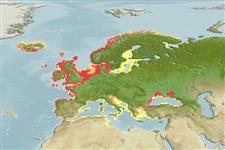Common names from other countries
Environment: milieu / climate zone / depth range / distribution range
экология
; солоноватоводный; пределы глубины 0 - 50 m (Ref. 434). Subtropical, preferred 11°C (Ref. 107945); 74°N - 23°N, 16°W - 44°W
Northeast Atlantic and the Mediterranean.
Length at first maturity / Size / Вес / Возраст
Maturity: Lm ? range ? - ? cm Max length : 8.9 cm TL самец/пол неопределен; (Ref. 434)
Found in both marine and oligohaline waters (Ref. 95752). Also inhabits brackish lagoons (Ref. 2779). Found on fine sand or slightly muddy sand (Ref. 434); also over coarse sand (Ref. 96391). Juveniles are epifaunal on seagrass and bare sand flats (Ref. 106879). Mobile (Refs. 95752, 96470). Free-living (Ref. 3123). Able to occupy areas with high exposure and low salinity (Ref. 95730). Carnivorous (Refs. 95752, 96470). Feeds on small benthic organisms (small crustaceans, annelids and mollusks) and fishery discards (Ref. 434).
Life cycle and mating behavior
половая зрелость | размножение | нерест | икра | Fecundity | личинки
Members of the order Decapoda are mostly gonochoric. Mating behavior: Precopulatory courtship ritual is common (through olfactory and tactile cues); usually indirect sperm transfer.
Основная ссылка
ссылки | координатор | соавторы
Fischer, W., G. Bianchi and W.B. Scott (eds.). 1981. (Ref. 434)
Статус Красного Списка МСОП (Ref. 130435)
Статус СИТЕС (Ref. 108899)
Not Evaluated
Not Evaluated
Использование человеком
рыболовство: коммерческий
FAO - рыболовство: landings, Видовой профиль | FishSource | Sea Around Us
инструменты
дополнительная информация
ресурсы в Интернет
Estimates based on models
Preferred temperature
(Ref.
115969): 8.6 - 14, mean 10.5 (based on 410 cells).
устойчивость к внешним воздействиям
низкий, минимальное время удвоения популяции 4.5-14 лет (K=0.09-0.11).
Уязвимость
Low vulnerability (10 of 100).
